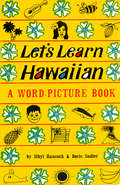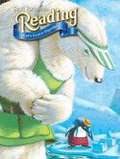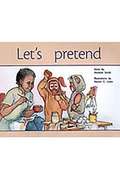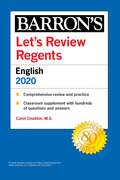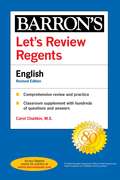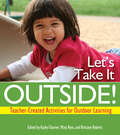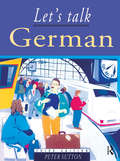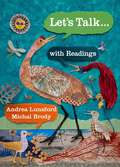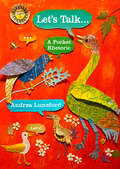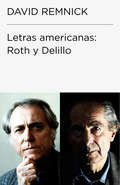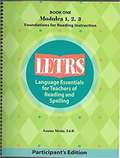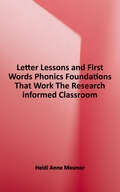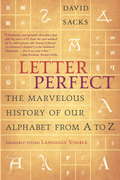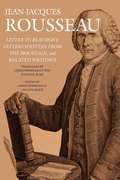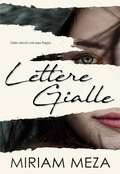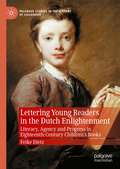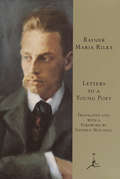- Table View
- List View
Let's Learn Hawaiian: A Word-Picture Book
by Doris Sadler Sibyl HancockAloha! Welcome to Hawaii! Travel through the pages of this very charming word-and-picture storybook.The many attractively arranged illustrations will have special appeal for children. The words here are simple ones we might use everyday. <P><P>There is laughter here, too--so important to keep a child's attention and help put an idea across.But it is not only children who can benefit from this presentation, a unique arrangement of pictures and facts about Hawaii. It should be of particular interest to adults and parents, teachers in the classroom, travelers to the Islands, or those simply interested in learning something about Hawaii, its language and traditions.Come with us to taste a fresh white niu, hear an old Hawaiian mele, or wiggle your toes in the moana. Some of the charms and flavor of the Islands are here; we hope that you will find it and want to come back to read this Hawaiian picture storybook again and again!
Let's Learn Together
by Scott ForesmanQuality literature, built-in skill instruction, and test preparation help every child become a successful reader who is prepared for state and national tests. The Grade 1 On-Level Readers provide six weeks of review for the skills previously covered in kindergarten.
Let's Pretend (Rigby PM Plus Blue (Levels 9-11), Fountas & Pinnell Select Collections Grade 3 Level Q #Red (Level 4))
by Annette Smith Naomi C. LewisThis is the second story about the twins, Matthew and Emma. Mum is painting the children's faces as she perpares them for a fancy dress party. Matthew's initial disappointment eventually turns to delight.
Let's Review Regents: English 2020 (Barron's Regents)
by Carol ChaitkinBarron's Let's Review Regents: English 2020 gives students the step-by-step review and practice they need to prepare for the Regents exam. This updated edition is an ideal companion to high school textbooks and covers all English topics prescribed by the New York State Board of Regents. This edition features:One actual full-length New York State Regents examInstructions on reading prose fiction, prose nonfiction, and poetry for understandingReview of the fundamentals of essay writing and advises on writing for the Regents examReview of grammar, vocabulary, and spellingLooking for additional review? Check out Barron&’s Regents English Power Pack 2020 two-volume set, which includes Let&’s Review Regents: English 2020 in addition to the Regents Exams and Answers: English 2020 book.
Let's Review Regents: English Revised Edition (Barron's Regents NY)
by Carol ChaitkinBarron's Let's Review Regents: English gives students the step-by-step review and practice they need to prepare for the Regents exam. This updated edition is an ideal companion to high school textbooks and covers all English topics prescribed by the New York State Board of Regents. All Regents test dates for 2020 have been canceled. Currently the State Education Department of New York has released tentative test dates for the 2021 Regents. The dates are set for January 26-29, 2021, June 15-25, 2021, and August 12-13th. This edition features:One actual full-length New York State Regents examInstructions on reading prose fiction, prose nonfiction, and poetry for understandingReview of the fundamentals of essay writing and advises on writing for the Regents examReview of grammar, vocabulary, and spellingLooking for additional review? Check out Barron&’s Regents English Power Pack two-volume set, which includes Let&’s Review Regents: English in addition to the Regents Exams and Answers: English book.
Let's Send a Letter!
by Kristin CashoreThe fun and excitement of English and Language Arts learning continues in Grade 2 of Reading Street. This comprehensive and dynamic curriculum for homeschooling is geared toward young children who have some foundational English and Language Arts knowledge and are ready to strengthen their skills. Comprised of engaging activities, challenging content and weekly quizzes, Reading Street: Grade 2 is the next step in your child's path toward becoming a lifelong learner and reader. As with all Reading Street products, the Grade 2 system is formatted to help students meet certain age-appropriate goals. After completing this English and Language Arts homeschool program, your child should be able to: Read and comprehend two-syllable words. Identify common prefixes (such as pre-, un-, or re-) and suffixes (such as -able, -ad and -er). Correct mistakes made when reading out loud. Read books with two or more chapters. Understand the structure of stores (i. e. beginning, middle and end). Start selecting reading materials based on his/her own interests. Identify the "who," "what," "when," "where," "why" and "how" of the text. While the goals of second Grade English and Language Arts are numerous, Reading Street will help you craft engrossing lessons. Your child will garner important English and Language Arts skills while completing a workbook, reading stories and poems, and taking assessments. Planning these lessons will be easier than ever, as all Reading Street systems are broken down into weekly Big Ideas. All the work your child does on a given week is formulated around that single concept for an organized and challenging curriculum. With six easy-to-follow units, Reading Street: Grade 2 is the perfect tool for homeschooling parents. Your child will enjoy the reading selections and activities, and you'll love to see your student growing into a knowledgeable individual. We're confident that this product is the right one for you. For more information on the specific materials found in Grade 2 of Reading Street, check out the Features and Benefits page.
Let's Shake on It!
by Roger C. Farr Dorothy S. StricklandThis book will let you meet many new characters and will take you to new places. You'll read about two friends that dream the same dream. You'll see that a bear and a mouse can find something they both like. You'll see that people can be different but also alike.
Let's Take It Outside!: Teacher-Created Activities for Outdoor Learning
by Kathy Charner Mary Rein Brittany RobertsChildren love outdoor play. Now teachers can combine the magic and excitement of the outdoors with activities that encourage and support learning! With more than 100 new teacher-created, classroom-tested outdoor activities, Let's Take It Outside! engages children's minds and bodies as they explore the limitless bounds of the outdoors while also building key skills in areas like math, literacy and language, science, art, and music. Perfect for ages 3 to 6, the activities in Let's Take It Outside! take kids on an outdoor adventure as they make mud-dough letters, go on a rainbow scavenger hunt, and play animal charades. Let's Take It Outside! is the result of a nationwide contest among teachers. The best of the best activities are selected and organized by theme for easy use. * Counting * Alphabet * Colors * Shapes * Art * Touch * Sound and sight * Plants and gardening * Bubbles and air * Light and shadow * Animals and insects * Dramatic play * Large motor skills
Let's Talk About Race in Storytimes
by Jessica Anne BrattWith the help of this book’s adaptable storytime activities, tools for self-reflection, and discussion starters, children’s librarians will learn how to put anti-racism work into their professional practice while fostering an environment that celebrates all identities. <p><p>As the weekly lists of best-sellers demonstrate, many people want to engage with racial issues. But when it comes to talking about race, they often don’t know how or are hesitant to take the first steps. This includes children's librarians, who are taking seriously our profession’s calls for diversity, equity, and inclusion. They already know that popular storytimes can be an effective way to increase community representation and belonging at the library. Incorporating race into storytimes is an ideal way to foster inclusion by normalizing conversations about these issues. <p><p>This book will help public and school librarians face their own biases, showing them how to have honest discussions with children, their caregivers, and storytime attendees, as well as their colleagues.
Let's Talk German: Pupil's Book 3rd Edition
by Peter SuttonA German language course for adult beginners, both independent learners and those following adult education courses. It has been updated to reflect developments in the language and culture of German-speaking nations, and also the political changes in Germany. Audio files to accompany the book are available to download from www.routledge.com/cw/sutton .
Let's Talk with Readings (First Edition)
by Andrea A. Lunsford Michal BrodyBrief, affordable, and by Andrea Lunsford: A rhetoric and a reader with a focus on curiosity, listening, and respect. Students like little books and they need ones they can afford. They need to read, write, and do research—and to listen with open minds and engage respectfully with new ideas and multiple perspectives. Let’s Talk with Readings covers all that, and its anthology of 31 readings, combined with the selections on the LetsTalkLibrary, will spark conversations about issues students will want to read about, think about, talk about, and write about. This purchase offers access to the digital ebook only.
Let's Talk...: A Pocket Rhetoric
by Andrea LunsfordA New Little Rhetoric, by Andrea Lunsford Students like little books. They want affordable course materials. They need to read and write and do research. And now they need more help than ever before listening, engaging respectfully with others, and distinguishing between facts and fiction. We’ve got the book for all that. It’s called Let’s Talk, and it’s by Andrea Lunsford. This purchase offers access to the digital ebook only.
Letras americanas: Roth y DeLillo (Colección Endebate #Volumen)
by David RemnickLos perfiles de dos novelistas fundamentales por el director del New Yorker. Nacidos con apenas tres años de diferencia, Philip Roth (1933) y Don DeLillo (1936) son dos glorias vivas de las letras americanas que han sido retratados por la ágil pluma de David Remnick. Pocos escritores concitan tanta unanimidad como el estadounidense Philip Roth. Es uno de los novelistas fundamentales de los últimos cincuenta años y fue el primer escritor vivo publicado en la Library of America. En este extraordinario perfil, Remnick repasa las obras maestras de Roth, la polémica que acompañó sus inicios tras la publicación de El lamento de Portnoy, la depresión que a mediados de los 90 le llevó a refugiarse en la literatura y las opiniones de Roth sobre el futuro de la literatura y las raíces de su arte. Y si Roth es el escritor público, que se crece ante la hostilidad, Don DeLillo es el autor huidizo, que intenta evitar la exposición pública. Sin embargo, su obra, con cumbres como Submundo o Libra, le ha convertido en uno de los novelistas más prestigiosos de la actualidad. Remnick va en su busca a un pueblecito cercano a Nueva York y le acompaña en un paseo por su barrio natal para buscar los temas y las preocupaciones que marcan sus novelas.
Letrs: Language Essentials For Teachers Of Reading And Spelling
by Louisa Moats"The first module in the LETRS series explores the reasons why many students have reading difficulties and explains how children learn to read. Case studies illustrate the progression of reading development; the influences of biological, genetic, cognitive, environmental, and instructional factors in learning to read; and the components of effective reading instruction.
Letter Cards, Grade K (Into Reading, Read Aloud Module 10)
by Houghton Mifflin Harcourt Publishing CompanyNIMAC-sourced textbook
Letter Cards, Grades 1-2 (Into Reading, Read Aloud Module 3)
by Houghton Mifflin Harcourt Publishing CompanyNIMAC-sourced textbook
Letter Lessons and First Words: Phonics Foundations that Work
by Heidi Anne MesmerIf you're not sure how phonics fits within your daily instruction, or crave a more effective process for teaching phonics, Heidi Anne Mesmer is here to help. In Letter Lessons and First Words, Heidi Anne provides a research-based vision of what lively, engaging phonics instruction can look like, along with practical, classroom-tested tools to make it happen in your classroom. Heidi Anne provides a one-stop shop for phonics instruction, including a clear scope and sequence of what to teach, a quick assessment to differentiate instruction, a simple lesson framework, and three activity-filled units matching key developmental milestones. <p><p>More than twenty classroom videos bring the content to life, showing children working with letters, words, and books at various stages of learning. Additional resources include: - A "know the code" chapter explaining English spelling (and online glossary) - Answers to common questions - Guidance about choosing books for readers at different stages - new info about how children cognitively store words and why inductive tension is important. Isn't it time to re-imagine how you teach phonics? Letter Lessons and First Words will show you the way toward joyful instruction for today's classrooms.
Letter Perfect: The Marvelous History of Our Alphabet From A to Z
by David SacksDavid Sacks has embarked on a fun, lively, and learned excursion into the alphabet-and into cultural history-in Letter Perfect. Clearly explaining the letters as symbols of precise sounds of speech, the book begins with the earliest known alphabetic inscriptions (circa 1800 b.c.), recently discovered by archaeologists in Egypt, and traces the history of our alphabet through the ancient Phoenicians, Greeks, and Romans and up through medieval Europe to the present day. But the heart of the book is the twenty-six fact-filled "biographies" of letters A through Z, each one identifying the letter's particular significance for modern readers, tracing its development from ancient forms, and discussing its noteworthy role in literature and other media. We learn, for example, why letter X may have a sinister and sexual aura, how B came to signify second best, why the word mother in many languages starts with M. Combining facts both odd and essential, Letter Perfect is cultural history at its most accessible and enjoyable.From the Trade Paperback edition.
Letter To Beaumont, Letters Written From The Mountain, And Related Writings
by Jean-Jacques Rousseau Christopher Kelly Eve Grace Judith R. BushPublished between 1762 and 1765, these writings are the last works Rousseau wrote for publication during his lifetime. Responding in each to the censorship and burning of Emile and Social Contract, Rousseau airs his views on censorship, religion, and the relation between theory and practice in politics. <p><p> The Letter to Beaumont is a response to a Pastoral Letter by Christophe de Beaumont, Archbishop of Paris (also included in this volume), which attacks the religious teaching in Emile. Rousseau's response concerns the general theme of the relation between reason and revelation and contains his most explicit and boldest discussions of the Christian doctrines of creation, miracles, and original sin. <p> In Letters Written from the Mountain, a response to the political crisis in Rousseau's homeland of Geneva caused by a dispute over the burning of his works, Rousseau extends his discussion of Christianity and shows how the political principles of the Social Contract can be applied to a concrete constitutional crisis. One of his most important statements on the relation between political philosophy and political practice, it is accompanied by a fragmentary "History of the Government of Geneva." <p> Finally, "Vision of Peter of the Mountain, Called the Seer" is a humorous response to a resident of Motiers who had been inciting attacks on Rousseau during his exile there. Taking the form of a scriptural account of a vision, it is one of the rare examples of satire from Rousseau's pen and the only work he published anonymously after his decision in the early 1750s to put his name on all his published works. Within its satirical form, the "Vision" contains Rousseau's last public reflections on religious issues. <p> Neither the Letter to Beaumont nor the Letters Written from the Mountain has been translated into English since defective translations that appeared shortly after their appearance in French. These are the first translations of both the "History" and the "Vision."
Letter Writing and Language Change
by Daniel Schreier Anita Auer Daniel Schreier Richard J. Watts Anita AuerLetter Writing and Language Change outlines the historical sociolinguistic value of letter analysis, both in theory and practice. The chapters in this volume make use of insights from all three 'Waves of Variation Studies', and many of them, either implicitly or explicitly, look at specific aspects of the language of the letter writers in an effort to discover how those writers position themselves and how they attempt, consciously or unconsciously, to construct social identities. The letters are largely from people in the lower strata of social structure, either to addressees of the same social status or of a higher status. In this sense the question of the use of 'standard' and/or 'nonstandard' varieties of English is in the forefront of the contributors' interest. Ultimately, the studies challenge the assumption that there is only one 'legitimate' and homogenous form of English or of any other language.
Lettere Gialle
by Miriam MezaTutto iniziò con una bugia… Quando ti vidi per la prima volta, mi innamorai del tuo spirito selvaggio, del tuo essere libera e di come mi facevi sentire. Ma tutto era una bugia, non è vero? Una delle migliaia che abbiamo raccontato. Era più facile fingere e ignorare i segnali. Era più facile scriverci lettere e tenerci per mano. Ma quello è stato un mio errore, credo. Reggerti il gioco. Ora non ci sei… Un giorno semplicemente sei sparita mettendo il mio mondo sottosopra. Non c'è un solo posto in cui non ti abbiano cercata e nessuno sembra sapere dove tu sia. Ti sei dileguata senza lasciare traccia e ora tutti mi guardano con sospetto perché, secondo loro, nessuno ti conosce come me. La tua partenza è un mistero per tutti. Quello che non sanno, è che c'è un mistero ancora più grande. E sei tu. Ma non preoccuparti, Liv. Perché, costi quel che costi, io ti troverò.
Lettering Young Readers in the Dutch Enlightenment: Literacy, Agency and Progress in Eighteenth-Century Children’s Books (Palgrave Studies in the History of Childhood)
by Feike Dietz'This book presents a rigorous, hugely informative analysis of the early history of Dutch children’s literature, pedagogical developments and emerging family formations. Thoroughly researched, Dietz’s study will be essential for historians of eighteenth-century childhood, education and children’s books, both in the Dutch context and more widely.’— Matthew Grenby, Newcastle University, UK. ‘A rich, informative, well-documented and effectively illustrated discussion of the ways Dutch eighteenth-century educators tried to transform youth into responsible readers. It does so in a wide international context and masterfully connects this process to the radical politicization and de-politicization of Dutch society in the revolutionary period.’—Wijnand W. Mijnhard, formerly of Utrecht University, the Netherlands, and theUniversity of California at Los Angeles, USA.This book explores how children’s literature and literacy could at once regulate and empower young people in the eighteenth-century Dutch Republic. Rather than presenting the history of childhood as a linear story of increasing agency, it suggests that we view it as a continuous struggle with the impossibility of full agency for young people. This volume demonstrates how this struggle informed the production of books in a historical context in which the development of independent youths was high on the political agenda. In close interaction with international children’s literature markets, Dutch authors developed new strategies to make the members of young generations into capable readers and writers, equipped to organize their own minds and bodies properly, and to support a supposedly declining fatherland.
Letters Home
by Sylvia PlathIn answer to the avalanche of inquiries that has descended upon the author ever since the publication of Sylvia's poems in Ariel and her novel, The Bell Jar, she is releasing a section of her intimate correspondence with her family from the time she entered Smith College. It may seem extraordinary that someone who died when she was only thirty years old left behind 696 letters written to her family between the beginning of her college years in 1950 and her death early in February 1963. We could not afford long-distance telephoning, though, and Sylvia loved to write--so much so that she went through three typewriters in that same time.
Letters To a Young Poet
by Rainer Maria RilkeRilke&’s Letters to a Young Poet are arguably the most famous and beloved letters of the twentieth century. Written when the poet was himself still a young man, with most of his greatest work before him, they were addressed to a student who had sent Rilke some of his own writing, asking for advice on becoming a writer. The two never met, but over a period of several years Rilke wrote him these ten letters, which have been cherished by hundreds of thousands of readers for what Stephen Mitchell calls in his Foreword the "vibrant and deeply felt experience of life" that informs them. Eloquent and personal, Rilke&’s meditations on the creative process, the nature of love, the wisdom of children, and the importance of solitude offer a wealth of spiritual and practical guidance for anyone. At the same time, this collection, in Stephen Mitchell&’s definitive translation, reveals the thoughts and feelings of one of the greatest poets and most distinctive sensibilities of the twentieth century.
